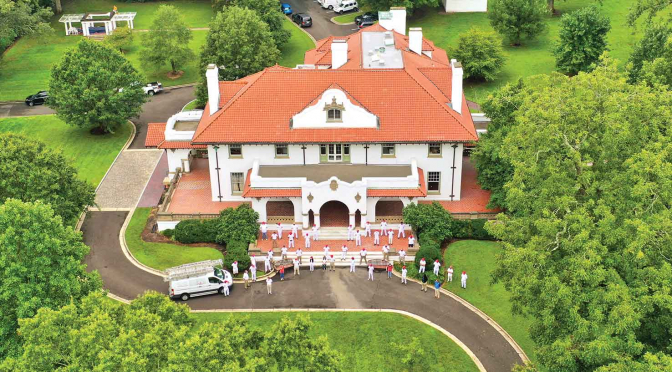For this article, PPC editor Mike Starling sat down with Anderson Painting to learn more about their work on the Hill House, a century-old home and well-known, well-preserved landmark in Durham, North Carolina.
A palatial place in a storied neighborhood
Named a National Historic District in 1985, Morehead Hill was home to many of the early industrialists of the city of Durham, North Carolina.
“From an 1890s Queen Anne to a 1950s stylish ranch, the neighborhood is full of interesting architecture and family histories,” says Preservation Durham. Chief among these is an opulent 17,000 square foot, nine-bedroom Spanish Colonial Revival style house built for financier and philanthropist John Sprunt Hill in 1912.
“The Hill House was the most impressive house to be built in Durham since the 1880s and as such symbolized the enduring, indeed steadily increasing, prosperity of the city’s businesses,” the preservation group says.
In memory of his wife, Hill bequeathed the mansion to the Annie Watts Hill Foundation, which was created to support non-sectarian, non-political female organizations.
Today, the Hill House is listed in the National Register of Historic Places and serves as a meeting place for local groups and is also home to the Junior League of Durham and Orange Counties. The entire interior and exterior of the home was repainted in 2020.
Historic challenges
Anderson Painting, a commercial and residential painting company based in nearby Raleigh, won the bid to repaint the house.
“One of the main challenges of the project was working over the fragile, historic clay tile roofing,” says Nate Anderson, who founded Anderson Painting with his wife Megan in 2006. “On the interior, covering historic areas that were not getting coated was extremely important. We were also dealing with lead paint both on the interior and exterior. That meant taking a number of extra precautions to ensure the safety of our employees and all those onsite.”
Anderson Painting is a lead paint certified firm. They used a wet scrape to contain the lead dust, and in general made sure all surface prep was done in compliance with the EPA’s strict guidelines.
Deadline and product pressure
Time was also a challenge on this job.
“We staffed this project with multiple crews, in order to hit the deadlines,” Anderson says. Prompt and attentive customer service from their Sherwin- Williams team was a big help on this and other aspects of the job.
“Our painting rep met us on site multiple times to discuss product compatibility,” Anderson says. “This being a historic renovation, the choice of products was also extremely important.”
To ensure the highest quality results, Anderson Painting relied on the best-in-class overall performance of the Emerald® product line throughout the project. Interior walls were coated with Emerald Interior Acrylic Latex, and Emerald Urethane Trim Enamel was used on the trim.
“Emerald Urethane is an alternative to using an oil-based primer and paint,” Anderson says. “It bonds really well with harder surfaces.”
They used Emerald Exterior Acrylic Latex on the exterior trim. “Emerald Exterior has great coverage and flows well,” he says.
For the exterior concrete, they primed with Loxon® Acrylic Conditioner Clear to seal the stucco before applying a topcoat of ConFlex® Sherlastic Elastomeric Coating.
“ConFlex was our best option for the stucco because of its elastomeric qualities,” Anderson says.
This product covers and hides hairline cracks while helping prevent water from penetrating into building interiors. It’s designed to not trap moisture vapor inside, reducing callbacks due to blistering, and offers excellent protection from wind-driven rain and harsh weather conditions. Using it in conjunction with Loxon Conditioner helps the exterior finish resist alkali and efflorescence.
ConFlex 7% Siloxane Water Repellant was selected to protect exposed stone window sills, railings and ornate medallions attached to the stucco.
In addition, there were many ornate wood soffits and exposed rafters. After sanding those sections, WoodScapes Exterior Semi-Transparent House Stain was applied to seal and protect the surface.
The final results were more than worth all the painstaking work.
“This was the largest lead renovation our company has ever completed,” Anderson says. “It was also rewarding to work on such a high-profile site. This Spanish Colonial Revival style mansion is one of the most opulent survivors of the homes built for the city’s early 20th century elite. We took pride in the fact that we played a part in preserving such a beloved, iconic home in the Durham community.”
This article was originally published in the Summer 2021 issue of PPC magazine. ®2021 Northbrook Publishing. Story by Mike Starling, PPC Editor. Photography courtesy Anderson Painting. Read about other successful painting projects in the PPC magazine archive.

